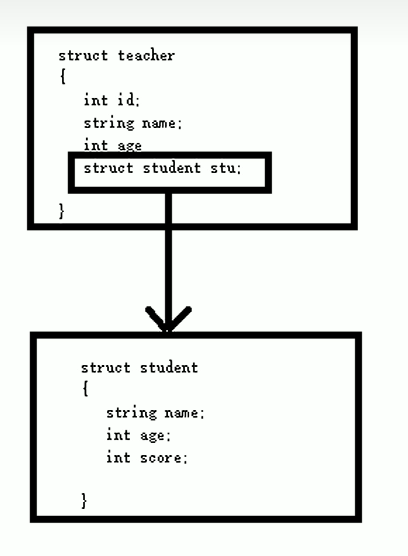8 结构体
8.1 结构体基本概念
结构体属于用户自定义的数据类型,允许用户存储不同的数据类型
8.2 结构体定义和使用
语法:struct 结构体名 { 结构体成员列表 };
通过结构体创建变量的方式有三种:
- struct 结构体名 变量名
- struct 结构体名 变量名 = { 成员1值 , 成员2值…}
- 定义结构体时顺便创建变量
示例:
//结构体定义
struct student
{
//成员列表
string name; //姓名
int age; //年龄
int score; //分数
}stu3; //结构体变量创建方式3
int main() {
//结构体变量创建方式1
struct student stu1; //struct 关键字可以省略
stu1.name = "张三";
stu1.age = 18;
stu1.score = 100;
cout << "姓名:" << stu1.name << " 年龄:" << stu1.age << " 分数:" << stu1.score << endl;
//结构体变量创建方式2
struct student stu2 = { "李四",19,60 };
cout << "姓名:" << stu2.name << " 年龄:" << stu2.age << " 分数:" << stu2.score << endl;
stu3.name = "王五";
stu3.age = 18;
stu3.score = 80;
cout << "姓名:" << stu3.name << " 年龄:" << stu3.age << " 分数:" << stu3.score << endl;
system("pause");
return 0;
}总结1:定义结构体时的关键字是struct,不可省略
总结2:创建结构体变量时,关键字struct可以省略
总结3:结构体变量利用操作符 ”.” 访问成员
8.3 结构体数组
作用:将自定义的结构体放入到数组中方便维护
语法:struct 结构体名 数组名[元素个数] = { {} , {} , ... {} }
示例:
//结构体定义
struct student
{
//成员列表
string name; //姓名
int age; //年龄
int score; //分数
}
int main() {
//结构体数组
struct student arr[3]=
{
{"张三",18,80 },
{"李四",19,60 },
{"王五",20,70 }
};
for (int i = 0; i < 3; i++)
{
cout << "姓名:" << arr[i].name << " 年龄:" << arr[i].age << " 分数:" << arr[i].score << endl;
}
system("pause");
return 0;
}8.4 结构体指针
作用:通过指针访问结构体中的成员
- 利用操作符
->可以通过结构体指针访问结构体属性
示例:
//结构体定义
struct student
{
//成员列表
string name; //姓名
int age; //年龄
int score; //分数
};
int main() {
struct student stu = { "张三",18,100, };
struct student * p = &stu;
p->score = 80; //指针通过 -> 操作符可以访问成员
cout << "姓名:" << p->name << " 年龄:" << p->age << " 分数:" << p->score << endl;
system("pause");
return 0;
}总结:结构体指针可以通过 -> 操作符 来访问结构体中的成员
8.5 结构体嵌套结构体
作用: 结构体中的成员可以是另一个结构体
例如:每个老师辅导一个学员,一个老师的结构体中,记录一个学生的结构体

示例:
//学生结构体定义
struct student
{
//成员列表
string name; //姓名
int age; //年龄
int score; //分数
};
//教师结构体定义
struct teacher
{
//成员列表
int id; //职工编号
string name; //教师姓名
int age; //教师年龄
struct student stu; //子结构体 学生
};
int main() {
struct teacher t1;
t1.id = 10000;
t1.name = "老王";
t1.age = 40;
t1.stu.name = "张三";
t1.stu.age = 18;
t1.stu.score = 100;
cout << "教师 职工编号: " << t1.id << " 姓名: " << t1.name << " 年龄: " << t1.age << endl;
cout << "辅导学员 姓名: " << t1.stu.name << " 年龄:" << t1.stu.age << " 考试分数: " << t1.stu.score << endl;
system("pause");
return 0;
}总结:在结构体中可以定义另一个结构体作为成员,用来解决实际问题
8.6 结构体做函数参数
作用:将结构体作为参数向函数中传递
传递方式有两种:
- 值传递
- 地址传递
示例:
//学生结构体定义
struct student
{
//成员列表
string name; //姓名
int age; //年龄
int score; //分数
};
//值传递
void printStudent(student stu )
{
stu.age = 28;
cout << "子函数中 姓名:" << stu.name << " 年龄: " << stu.age << " 分数:" << stu.score << endl;
}
//地址传递
void printStudent2(student *stu)
{
stu->age = 28;
cout << "子函数中 姓名:" << stu->name << " 年龄: " << stu->age << " 分数:" << stu->score << endl;
}
int main() {
student stu = { "张三",18,100};
//值传递
printStudent(stu);
cout << "主函数中 姓名:" << stu.name << " 年龄: " << stu.age << " 分数:" << stu.score << endl;
cout << endl;
//地址传递
printStudent2(&stu);
cout << "主函数中 姓名:" << stu.name << " 年龄: " << stu.age << " 分数:" << stu.score << endl;
system("pause");
return 0;
}总结:如果不想修改主函数中的数据,用值传递,反之用地址传递
8.7 结构体中 const使用场景
作用:用const来防止误操作
将函数中的形参改为指针,可以减少内存空间,而且不会复制新的副本出来
示例:
//学生结构体定义
struct student
{
//成员列表
string name; //姓名
int age; //年龄
int score; //分数
};
//const使用场景
void printStudent(const student *stu) //加const防止函数体中的误操作
{
//stu->age = 100; //操作失败,因为加了const修饰
cout << "姓名:" << stu->name << " 年龄:" << stu->age << " 分数:" << stu->score << endl;
}
int main() {
student stu = { "张三",18,100 };
printStudent(&stu);
system("pause");
return 0;
}8.8 结构体案例
8.8.1 案例1
案例描述:
学校正在做毕设项目,每名老师带领5个学生,总共有3名老师,需求如下
设计学生和老师的结构体,其中在老师的结构体中,有老师姓名和一个存放5名学生的数组作为成员
学生的成员有姓名、考试分数,创建数组存放3名老师,通过函数给每个老师及所带的学生赋值
最终打印出老师数据以及老师所带的学生数据。

示例:
#define _CRT_SECURE_NO_WARNINGS
#include <iostream>
#include <string>
#include <cstdlib> // 用于rand()
#include <ctime> // 用于time()
using namespace std;
struct student {
string name;
int score;
};
struct teacher {
string name;
student sArray[5]; // 每个老师有5名学生
};
// 修正:为老师和学生正确赋值
void allocateSpace(teacher tArray[], int len) {
string nameSeed = "ABCDE"; // 用于生成姓名的字母种子
// 遍历每个老师,为其赋值并初始化学生数据
for (int i = 0; i < len; i++) {
// 老师姓名:Teacher_A, Teacher_B, Teacher_C(假设len=3)
tArray[i].name = "Teacher_";
tArray[i].name += nameSeed[i];
// 为当前老师的5名学生赋值
for (int j = 0; j < 5; j++) {
// 学生姓名:Student_A, Student_B...(按老师分组)
tArray[i].sArray[j].name = "Student_";
tArray[i].sArray[j].name += nameSeed[j];
// 生成随机分数(60~100)
tArray[i].sArray[j].score = 60 + rand() % 41; // rand()%41范围0-40,+60后60-100
}
}
}
void PrintInfo(teacher tArray[], int len) {
for (int i = 0; i < len; i++) {
cout << "老师的名字:" << tArray[i].name << endl;
// 遍历当前老师的5名学生
for (int j = 0; j < 5; j++) {
cout << "\t学生姓名:" << tArray[i].sArray[j].name
<< " 考试分数:" << tArray[i].sArray[j].score << endl;
}
cout << endl; // 每个老师信息后换行
}
}
int main() {
srand((unsigned int)time(NULL)); // 初始化随机数种子(需包含<ctime>)
// 定义3名老师的数组
teacher tArray[3];
int len = sizeof(tArray) / sizeof(tArray[0]); // 老师数组长度=3
allocateSpace(tArray, len); // 分配数据
PrintInfo(tArray, len); // 打印数据
system("pause");
return 0;
}8.8.2 案例2
案例描述:
设计一个英雄的结构体,包括成员姓名,年龄,性别;创建结构体数组,数组中存放5名英雄。
通过冒泡排序的算法,将数组中的英雄按照年龄进行升序排序,最终打印排序后的结果。
五名英雄信息如下:
{"刘备",23,"男"},
{"关羽",22,"男"},
{"张飞",20,"男"},
{"赵云",21,"男"},
{"貂蝉",19,"女"},示例:
//英雄结构体
struct hero
{
string name;
int age;
string sex;
};
//冒泡排序
void bubbleSort(hero arr[] , int len)
{
for (int i = 0; i < len - 1; i++)
{
for (int j = 0; j < len - 1 - i; j++)
{
if (arr[j].age > arr[j + 1].age)
{
hero temp = arr[j];
arr[j] = arr[j + 1];
arr[j + 1] = temp;
}
}
}
}
//打印数组
void printHeros(hero arr[], int len)
{
for (int i = 0; i < len; i++)
{
cout << "姓名: " << arr[i].name << " 性别: " << arr[i].sex << " 年龄: " << arr[i].age << endl;
}
}
int main() {
struct hero arr[5] =
{
{"刘备",23,"男"},
{"关羽",22,"男"},
{"张飞",20,"男"},
{"赵云",21,"男"},
{"貂蝉",19,"女"},
};
int len = sizeof(arr) / sizeof(hero); //获取数组元素个数
bubbleSort(arr, len); //排序
printHeros(arr, len); //打印
system("pause");
return 0;
}本网站原创文章版权归何大锤的狂飙日记所有。发布者:何大锤,转转请注明出处:何大锤的博客




